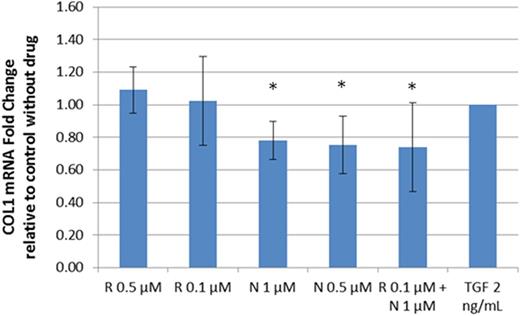Abstract
Myelofibrosis (MP) is characterized by stem cell-derived clonal myeloproliferation and a reactive cytokine-driven inflammatory bone marrow fibrosis (BMF). BMF plays an important role in MF symptom such us extramedullary hematopoiesis that implies hepatosplenomegaly and bone marrow failure with anemia and thrombocytopenia.
Ruxolitinib is the only drug approved for MF therapy. It was associated with significant reduction in symptomatic splenomegaly and improved constitutional symptoms (Harrison et al. N Engl J Med. 2012 Mar 1;366(9):787-98; Verstovsek et al. Haematologica2015 Apr;100(4):479-88). Recently, Masarova and co-workers reported a case a MF patient who achieved a complete remission, including the complete disappearance of BMF (Masarova et al. Blood. 2016 Jun 20).
In a previous work (Arenas et al. Blood Volume 122, Issue 21 (ASH Annual Meeting Abstrat)), we tried to identify the most promising synergistic drugs combinations for a Ruxolitinib. Nilotinib was selected between a set of synergistic drug. It is a BCR-ABL inhibitor but also is a potent PDGF-R inhibitor. Interestingly, different studies reported an anti-fibrotic activity in liver (Liu et al. J Hepatol. 2011 Sep;55(3):612-25.) and skin (Akhmetshina et al. FASEB J. 2008;22(7):2214-22). For these reasons we decided study the effect of the combination of Ruxolitinib and Nilotinib in BMF.
To determine the ideal concentration of TGF-β to induce collagen mRNA expression in HS27a, we treated the culture of HSP27a with increasing concentration of TGF-β (0.625-10 ng/mL) during 24h. The best TGF-β concentration was 2ng/mL, with a fold change of 2.74 (SD=0.89) (p<0.05) relative to control without TGF (figure 1).
Figure 1: Fold change in COL1 mRNA expression in HSP27a cell line relative to control without TGF-β. Two-sample Wilcoxon rank-sum (Mann-Whitney) test was performed. * p<0.05. R: Ruxolitinib. N: Nilotinib.
To assess the anti-fibrotic activity of Ruxolitinib and Nilotinib individually, we preincubated the HSP27a cultures with 0.1 - 0.5 µM of Ruxolitinib or 0.5 - 1 µM of Nilotinib during 1 h. After that, we added TGF-β during 24h. Both 0.5 - 1 µM of Nilotinib reduced the mRNA expression of COL1 with a fold change of 0.75 (SD = 17.6) (p<0.05) and 0.78 (SD = 11.5) (p<0.05) respectively, relative to control with TGF-β but without drug (figure 2).
Figure 2: Fold change in COL1 mRNA expression in HSP27a cell line relative to control with TGF-β but without drugs. Two-sample Wilcoxon rank-sum (Mann-Whitney) test was performed. * p<0.05. R: Ruxolitinib. N: Nilotinib.
Finally, to verify if the combination of both drug had the capacity of reducing COL1 expression, we pretreated the HS27a cultures with 0.1 µM of Ruxolitinib and 1 µM of Nilotinib simultaneously. The expression of COL1 were 74 % (SD = 27.32%) (p<0.05) relatively to control with TGF-β but without drug (figure 2).
In conclusion, Nilotinib have synergistic and anti-fibrotic activity individually, but also in combination with Ruxolitinib. For these reasons, the combined therapy Ruxolitinib-Nilotinib could be a promising therapy to MF and these results support a clinical trial of this combination in MF patients.
Martínez-López:Novartis: Honoraria, Speakers Bureau.
Author notes
Asterisk with author names denotes non-ASH members.



This feature is available to Subscribers Only
Sign In or Create an Account Close Modal